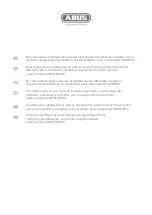
4
PCB
®
’
s ICP
®
constant-current power supply units provide the necessary excitation power
for proper operation of the Modal Punch. These units provide the correct power and have
circuit fault indicating meters and a bias decoupling capability to remove MOSFET turn
on bias voltage from the measurement signal. Power units are available in a variety of
configurations, including battery or AC versions and with additional signal conditioning
features such as gain, filtering, and integration. Some FFT analyzers incorporate the
proper excitation power for direct connection to ICP
®
sensors. Be certain to confirm that
the excitation from the power supply conforms to the requirements for the specific
sensors being used. The Modal Punch requires 2 to 20 mA constant current and 24 to 27
VDC.
CAUTION:
The Modal Punch was designed to operate only with ICP
®
power supply
units. Do not attempt to troubleshoot the Modal Punch by connecting it to any device,
such as an ohmmeter, which may introduce unregulated voltage, as damage to the
precision internal micro-electronics may occur. If there is any doubt about the
compatibility of a power supply unit or whether a power supply unit is required, feel free
to contact the PCB
®
Vibration Division customer service group by calling toll-free in the
USA 888-684-0013 (or outside the USA by calling 716-684-0001).
5.0 Testing
To test the behavior of your structure and to tailor the frequency bandwidth of the impact
force, follow the below operation instructions:
1). Position the Modal Punch on the test structure at the desired location. Strike the
punch with a standard non-instrumented hammer and process the results. Always take
several averages to reduce the effects of spurious noises.
CAUTION:
Never impact
without a tip properly installed on the Modal Punch, as permanent damage of the sensing
element is likely to occur. Also, care should be exercised when striking the punch to
ensure that the impact hammer does not slip and strike the operator
’
s hand, causing
personal injury.
2). Check the measured results for signal quality (adequate signal-to-noise) and no
overloads (overloads lights or sharp flattening of time history peaks).
3). Analyze the results for frequency content and check to ensure that the reasonably flat
portion of the force spectrum is sufficient to cover the structural resonances of interest
present in the acceleration spectrum. Often, signal energy is sufficient to excite structural
resonances at 20 dB below initial low frequency force levels.
4). Change Modal Punch tips to modify dynamic behavior, if necessary. The following
are general guidelines; the specific test structure plays an integral part in the selection:
A. To obtain higher frequency response, use a stiffer, harder tip and a smaller
hammer mass.
B. To obtain improved low frequency response, use a softer hammer tip and
larger hammer mass.
Summary of Contents for 088A
Page 14: ......
































